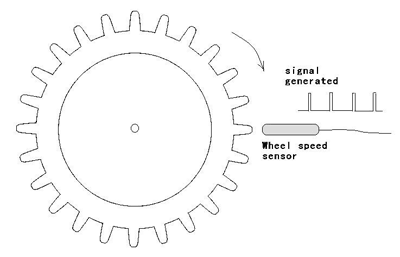Wheel Speed Sensors
- Basic Description
-
 Wheel Speed Sensors measure the road-wheel speed and direction of rotation.
These sensors provide input to a number of different automotive systems including the antilock
brake system and electronic stability control. Wheel speed sensors typically include a toothed
(or optically encoded) shaft and a magnetic (or optical) sensor. The sensor counts the rate at
which the teeth or marks pass by. Wheel speed sensors may monitor the crankshaft or driveshaft
rotation in vehicles that do not need to know the rate at which individual wheels are turning.
Otherwise, they monitor the rotation of the axle driving each wheel. Wheel Speed Sensors measure the road-wheel speed and direction of rotation.
These sensors provide input to a number of different automotive systems including the antilock
brake system and electronic stability control. Wheel speed sensors typically include a toothed
(or optically encoded) shaft and a magnetic (or optical) sensor. The sensor counts the rate at
which the teeth or marks pass by. Wheel speed sensors may monitor the crankshaft or driveshaft
rotation in vehicles that do not need to know the rate at which individual wheels are turning.
Otherwise, they monitor the rotation of the axle driving each wheel.
There are two types of magnetic sensors: variable reluctance and Hall effect. Both types detect
the teeth of a steel gear as it rotates beneath the sensor. Variable reluctance sensors detect the change in the inductance of a wire coil as a steel tooth comes into close proximity. Hall effect sensors measure the change in the resistance of a semi-conducting slab due to the strength of an applied magnetic field.
- Manufacturers
-
Allegro,
ATE,
Beru, Bosch, Bourns,
BWD,
D&R Technology,
Continental,
Delphi, Gill,
Honeywell,
NAPA Echlin,
Sensoronix,
TE Connectivity
- For More Information
- [1] Hall Effect Sensor, Wikipedia.
- [2] Wheel Speed Sensor, Wikipedia.
- [3] Diagnosing Wheel Speed Sensors: WSS, ABS Systems, Larry Carley, Brake And FrontEnd, Oct. 1, 2008.
- [4] Hall Effect WSS or Wheel Speed Sensor, YouTube, June 11, 2010.
- [5] Active WSS Operation Shorter Version, YouTube, May 17, 2013.
|

